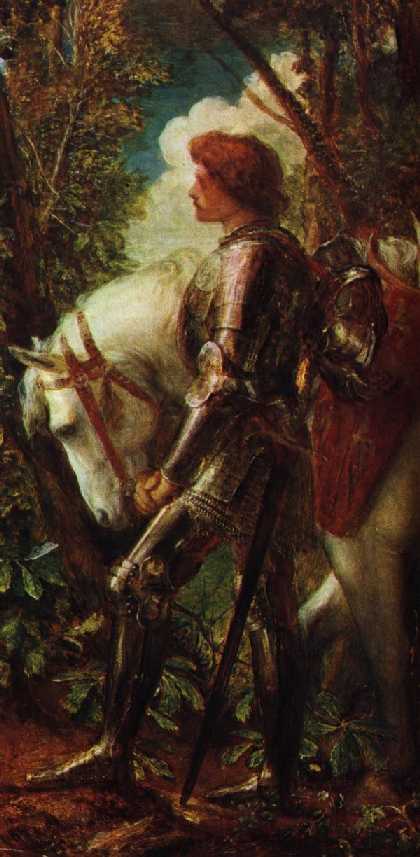



Maturity of Chivalry
Chivalry was in its vigor during the religious wars of the Crusades which lasted roughly from 1100 to 1600. By
the early fourteenth century, however, it was already showing evidence of decline, even though this was the period
when it outwardly assumed its most magnificent form, particularly in England, under the auspices of Edward III
and his immediate successors.Edward was a great lover of the display and trappings of chivalry, and his reign saw the rise of heraldry, the
widespread promotion of tournaments and banquets, the spreading fashion for courtly love, and an increase in the
writing of great epic romances. It was during this period, up until the Wars of the Roses, that some of the most
distinguished knights came to prominence: Sir Walter Manny, one of Edward III's most able commanders; Sir John
Chandos, perhaps the most beloved knight of the Middle Ages; Bertrand du Guesclin, France's best loved captain;
and Edward the Black Prince, 'the chief flower'of chivalry of all the world', according to the French chronicler,
Froissart. At the age of fourteen Edward fought for his knightly spurs at the Battle of Crecy.Towards the end of the golden age of chivalry, great importance was placed on bestowing of Orders, such as
those of the Garter, the Holy Spirit, the Golden Fleece and St James. These bound a knight and his sovereign in a
personal bond of brotherhood, a bond in which all were equal and all bound to come to each other's aid. These
Orders were an attempt to mobilize the ideology of chivalry in the service of politics now that feudal bonds were
becoming so weak.The Decline of Chivalry
Several factors combined to undermine the substance and spirit of chivalry during the late Middle Ages. It may
reasonably be argued that with the decline of the crusading ideal a serious decay was already under way. To begin
with, Pope Innocent III's declaration of a Crusade in 1208 against the Christian sect known as the Cathars living
in southern France had the effect of decimating the birthplace of romantic chivalry as many thousands of these
'heretics' were mercilessly put to death. Diverting resources from the Holy Land unfortunately undermined the
noble cause of Christian warfare, and this was compounded by the Pope's subsequent Crusades against his political
enemies, including the German Emperor, Frederick II.Louis IX's two disastrous Crusades of 1248 and 1267, followed by the rise of the Mamluks in Egypt and the siege
of Acre in 1291, brought about a decline in the golden age of crusading (although crusades continued in Eastern
Europe and the Mediterranean for generations to come). At this time, people also began to criticize the increasingly
wealthy and perhaps corrupt Crusading Orders. The great wealth and military strength of these Orders now became
a cause for concern and envy. In 1307 King Philip IV of France decreed the suppression of the Order of the
Templars. Forty-five of its members were burned in one day in the city of Paris and its Grand Master, Jacques de
Bourg Molay, was also burned at the stake on charges of heresy.During the fourteenth century, a great many political changes occured which further accelerated the decline of
chivalry. The feudal system of government which allowed the noble class of independant knights to evolve was now
being destroyed by the rise of soverignty. Kings began to employ mercenary troops to defend their realms, judging
the knight an unpredictable military force, unlikely to submit to periods of long service under the tight discipline of his
sovereign. With the eruption of the Hundred Years War between France and England in 1338, the knight continued
to lose out to the new breed of of paid soldier. Even his weaponry were becoming obsolete as gunpowder began to
take the place of lance and sword. Suddenly the well-armored knight, riding valiently into battle for the love of his
lady and the glory of chivalry, had lost its credibility. He took refuge in the tournaments, at one time an important
field of training, yet now an elaborately staged pageant, hopelessly removed from the developments of modern
warfare.Some desperate attempts were made in the fifteenth century to revive the old codes of chivalry, but as the years
progressed only traces of this lost institution remained. Religion no longer regulated the military spirit of men; knights
had forfeited their ancient splendor and had become mere soldiers, while the art of gallantry had deteriorated into
licentiousness.Chivalry, in its maturity, teased out the virtues and vices of humanity. Yet the qualities of valor, steadfastness and
justice, of courtesy, loyalty and obedience, although no longer publicly embraced, were never entirely forgotten.
The noble aims of chivalry left an enduring mark on society, and it would be difficult for anyone to deny that modern
courtesy is descended from the ideal of medieval chivalry, and ideal which proved as susceptible as any other to the
perilous pitfalls of practice.


a n @ m i c r o n . n e t URL: https://members.tripod.com/~aaron_neilson/decline.html